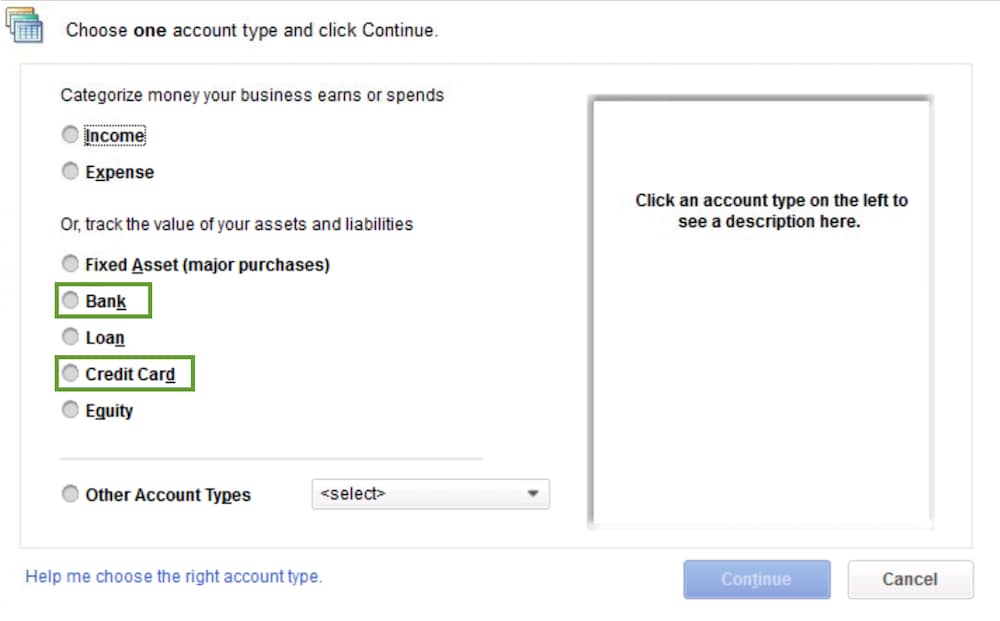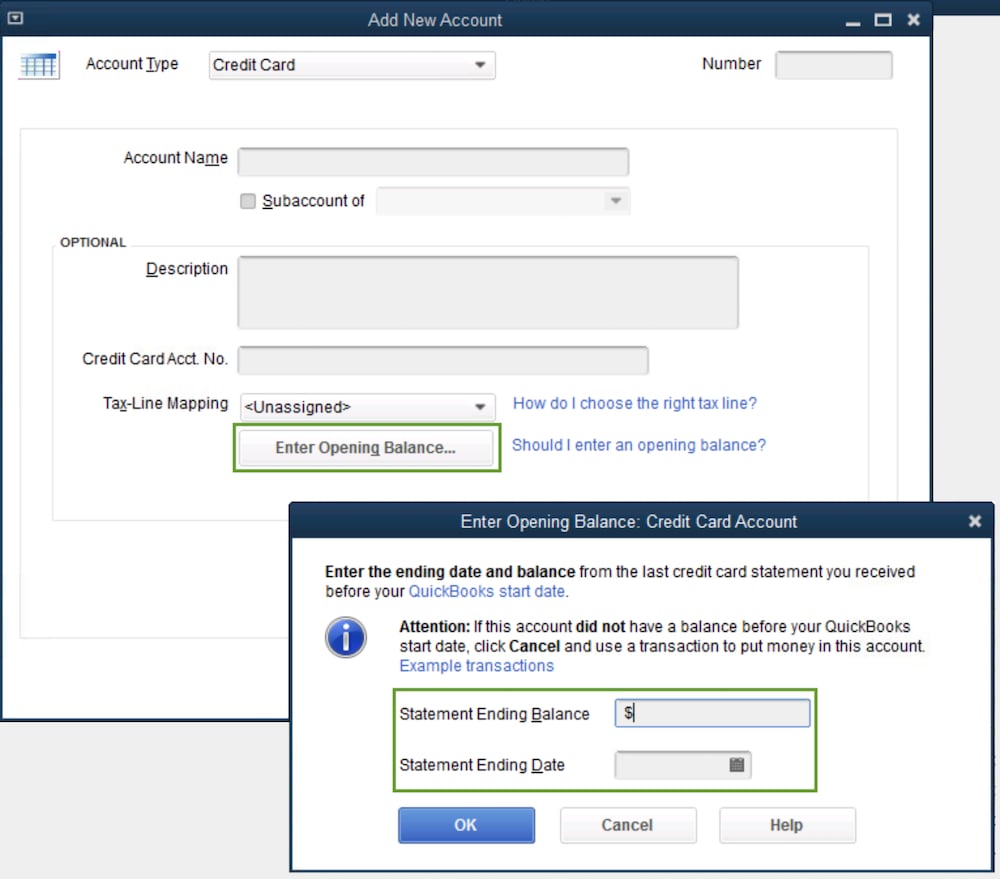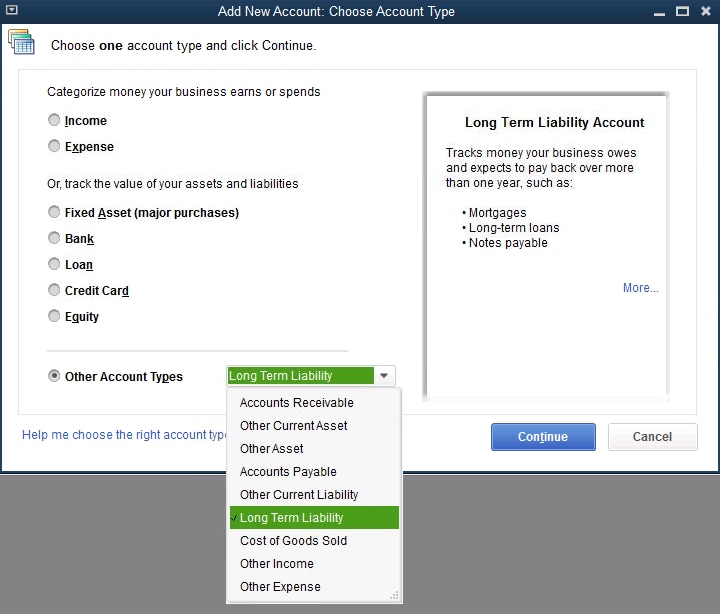Should I Enter Bank Balance Or Register Balance When Setting Up Quickbooks Bank Account
Acquire how to enter an opening balance for a bank, credit card, and other types of accounts.
When you lot create a new account in QuickBooks Desktop, choice a day to first tracking all of your transactions. You enter the balance of your real-life bank business relationship for the solar day you selection. This way, QuickBooks matches your banking concern records from the start.
This starting point is the business relationship'south opening residual. Information technology summarizes all the by transactions that came earlier it. Here'south how to enter an opening remainder for accounts you create in QuickBooks.
Step one: Enter an opening remainder
Follow the steps for the type of account the opening balance is for:
Bank or credit card accounts
Before you create a new account on your QuickBooks Chart of Accounts, brand sure you know what to enter for your opening balance .
Y'all tin enter an opening balance for a real-life bank account y'all just created, or one you've had for a while.
- Get your bank statements or sign in to your bank's website.
- In QuickBooks Desktop, get to the Company carte and and so select Chart of Accounts.
- Right-click anywhere on your Chart of Accounts and select New.
- SelectBank or Credit Card for the account type. Then select Continue.

- Give your account a proper name. If yous take multiple accounts of the same type or at the same bank, give them unique names so they're like shooting fish in a barrel to tell autonomously.
- Fill out the residue of the information fields.
- Select Enter Opening Remainder. Afterward on, if y'all need to edit your opening balance, the push volition be Change Opening Balance.
 What you lot enter as the opening remainder depends on how you want to handle your past transactions:
What you lot enter as the opening remainder depends on how you want to handle your past transactions:- If you don't plan to enter older transactions that come before the opening balance date in QuickBooks: Enter the ending balance and ending engagement from your most contempo bank statement. And so select OK. This summarizes all of your past transactions. You lot'll beginning tracking new transactions going forrad.
- If you lot want to enter your past transactions in detail: Decide how far back you want to become. Selection a date that's older than the oldest transaction you want to track in QuickBooks. Your opening residue summarizes everything before the engagement you pick. Enter the date you picked in the Ending date field. In the Ending balance field, enter the balance of your real-life account for that date. Then select OK. This method prevents you from counting past transactions twice.
- When you're done, select Save & Close to tape the opening balance.
Handle pending or outstanding payments:
Asset, liability, and other types of accounts
You tin can enter an opening balance for a existent-life banking concern business relationship y'all simply created, or one you've had for a while.
Be careful entering the opening balances for accounts on your Balance Sheet. This includes Fixed Asset, Equity, Long-term Liability, Other Assets, Other Current Asset, and Other Current Liability accounts.
If you're unsure or take questions, accomplish out to your accountant. If you don't have an accountant, nosotros can assistance you find one :
- Get your depository financial institution statements or sign in to your banking company's website.
- In QuickBooks Desktop, go to the Company bill of fare so select Chart of Accounts.
- Right-click anywhere on your Nautical chart of Accounts and select New.
- Select Fixed Asset, Loan, or Disinterestedness. For other types of accounts, select the Other Business relationship Types drop-downwards and one of the types. Then select Continue.

- Give your account a name. If you take multiple accounts of the aforementioned type or at the same bank, give them unique names and then they're piece of cake to tell apart.
- Fill out the balance of the data fields.
- Select Enter Opening Balance. Subsequently on, if you need to edit your opening balance, the button will exist Change Opening Rest. What yous enter for the opening balance depends on how y'all want to handle your by transactions:
- If you don't programme to enter older transactions that come before the opening balance date in QuickBooks: Enter the ending residue and ending engagement from your most recent bank statement. Then select OK. This summarizes all of your past transactions. You'll commencement tracking new transactions going forward.
- If you lot want to enter your past transactions in particular: Determine how far back you desire to get. Pick a date that'southward older than the oldest transaction you want to track in QuickBooks. Your opening residue summarizes everything earlier the appointment you pick. Enter the date you picked in the Ending date field. In the Catastrophe balance field, enter the balance of your existent-life account for that date. Then select OK. This method prevents you from counting past transactions twice.
- When you're done, select Save & Close to record the opening remainder.
Alternative: Create a journal entry for the opening balance
Income and expense accounts
You don't need to enter opening balances for income or expense accounts. These accounts simply rail your earnings and spending.
Client or vendor balances in Accounts Payable and Accounts Receivable
If your customers or vendors take outstanding balances from before your opening balance date, enter the private unpaid invoices or bills. This creates open balances that collectively effect in your Accounts Payable and Accounts Receivable opening balances.
Step 2: Bank check the opening remainder entry
Subsequently you lot enter the opening balance, go to your account register and brand sure information technology's accurate. The Opening Residuum Equity account shouldn't have a remaining residue.
- Become to theLists carte and selectChart of Accounts.
- Search for and open theOpening Residual Equity account.
- Check the account balance. Information technology should be 0.00.
If the residuum isn't 0.00, don't worry. Write downwardly the remaining balance. And so run a Balance Sail Report for concluding year.
- Go toReports and hover overCompany & Financial.
- SelectBalance Canvass Standard.
- From theDates dropdown, selectLast Financial Year.
- In the Equity section, check theRetained Earnings rest.
- Compare last yr'due south Retained Earnings balance with the remaining remainder in the Opening Balance Equity account.
If they match, you're skillful to get. Everything is balanced. If they don't friction match, achieve out to your accountant. They know how to go your accounts back in balance.
Should I Enter Bank Balance Or Register Balance When Setting Up Quickbooks Bank Account,
Source: https://quickbooks.intuit.com/learn-support/en-us/help-article/product-setup/enter-opening-balances-accounts-quickbooks-desktop/L4PfiNhRx_US_en_US
Posted by: cuellarlier1965.blogspot.com


0 Response to "Should I Enter Bank Balance Or Register Balance When Setting Up Quickbooks Bank Account"
Post a Comment